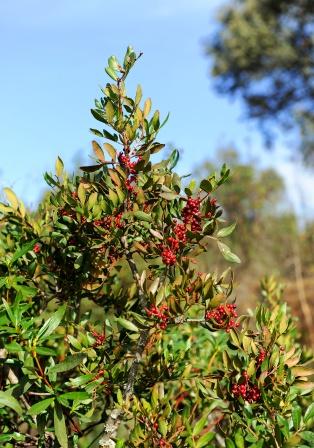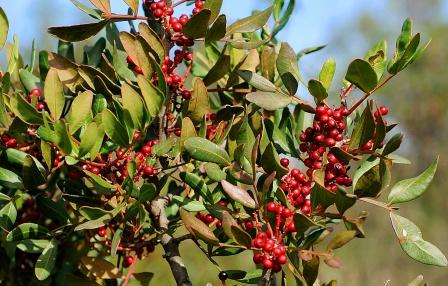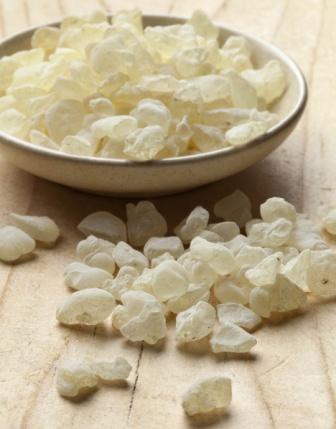Rumi Mastagi – Pistacia lentiscus Uses, Research
Rumi Mastagi – Pistacia lentiscus gum resin is used for its medicinal properties. It is an aphrodisiac and useful in liver disorders, burn wounds etc.
Botanical name- Pistacia lentiscus Linn
Family-Anacardaceae (Amra kula)

Table of Contents
Vernacular names
Names in different languages:
English name- Mastic
Gum is called Mastic tears of Chios
Hindi name-Matagi
Arabic name- Alkakhmi
Sanskrit Synonyms- Mastaki

Chemical composition
Pistacia lentiscus chemical composition:
Masticadiendiol, Masticadienonic acid, A-Pinene, Myrcene,a Polymeric procyanidin glycoside
Reference: Dravya Guna Vijnana, JLN Shastry

Medicinal qualities
Pistacia lentiscus medicinal qualities:
Rasa (taste) – Madhura – sweet, Kashaya – astringent
Guna (qualities) – Laghu – light to digest, Rooksha – Dryness
Vipaka-Madhura – sweet
Veerya – Ushna – Hot potency
Effect on Tridosha: Balances Vata and Pitta Dosha
Part used, dosage
Part used- Gum-resin, galls
Dosage- powder 1-3 g
Sanskrit verse

Uses
Rumi Mastagi Uses:
Strengthens the teeth
Balances Kapha dosha
Vrushya – aphrodisiac
Grahi – absorbent, bowel binding, useful in IBS, diarrhoea
Deepana – improves digestion strength
It is used in treating gastrointestinal ailments, high blood pressure, heart ailments, peptic ulcers,
Mastic oil is used in treating bacterial and fungal infections and is used in preparing ointments.
The gum is given in a dose of 500 mg to 1 gram to keep in the mouth to relieve bad breath problems and to strengthen teeth.
Interaction with medicines, supplements
Can this be used while taking Homeopathic medicine?
Yes. This product does not react with homeopathic medicine.
Can this medicine be continued while taking supplements like multivitamin tablets, Omega 3 fatty acids etc?
Yes. Generally, this product goes well with most dietary supplements. However, if you are taking more than one product per day, please consult your doctor for an opinion.
With western
medicines
Seek your
doctor’s advice if you are taking this product along with other western
(allopathic / modern) medicines. Some Ayurvedic herbs can interact with modern
medicine.
If both Ayurvedic and allopathic medicines are advised together, then it is
best to take Allopathic medicine first, wait for 30 minutes and then take the
Ayurvedic medicine.
Research
Bactiricidal properties of mastic gum. Mastic gum killed 50% of the strains tested at a concentration of 125 microg/ml and 90% at a concentration of 500 microg/ml. The influence of sub-MBCs of mastic gum on the morphologies of H. pylori was evaluated by transmission electron microscopy. The lentiscus resin induced blebbing, morphological abnormalities and cellular fragmentation in H. pylori cells.
aqueous extract of the plant suppressed iron-induced lipid per-oxidation in rat liver homogenates without affecting mitochondrial respiration in cultured HepG2 and PC12 cells.
Use in liver disorders
Volatile components of the resin
Efficacy against burn wounds of Virgin Fatty Oil
Ayurvedic medicines
Ayurvedic medicines with Rumi Mastagi as ingredient:
Liverson tablet – indicated in Ayurvedic treatment of infective and toxic hepatitis, jaundice, enlarged and fatty liver, liver cirrhosis, anorexia, alcoholism.
Sthanika karma (Systemic Acton)
Externally –Helps to improve complexion, Prevent bad odour, Strengthens the tooth, Pacifies the kapha dosha, Powder can be used in hemorrhages, bruises etc. In pashva sula (pain in the flanks) its paste is applied on the chest.
Internally
Digestive system –Carminative, facilitates normal movement of doshas, absorbent, liver stimulants. Indicated in low digestive fire, abdominal distension, malabsorption syndrome, Liver disorders.
Respiratory System – pacifies kapha . Indicated in kasa (Cough), breathing difficulty etc.
Excretory system – Increase urine production , indicated in dysuria
Reproductive System – Aphrodisiac, indicated in Dysmenorrhea










